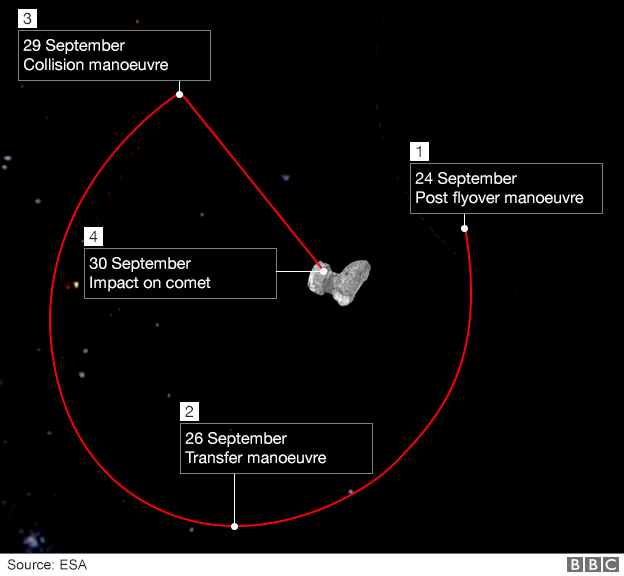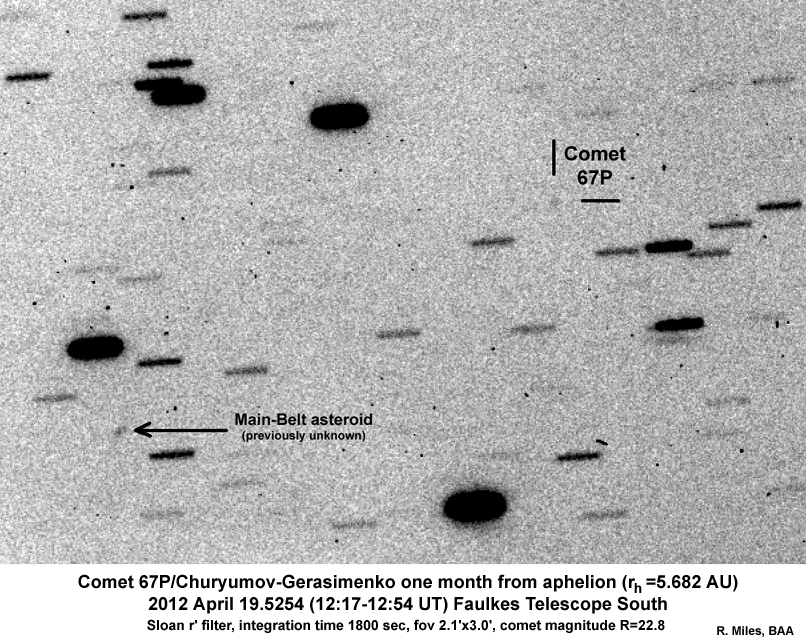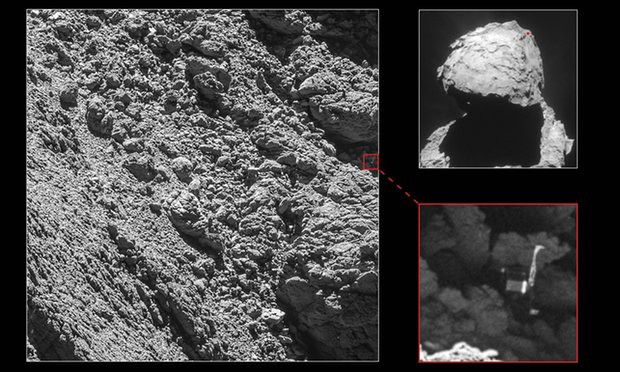-
Faulkes Telescope Project Privacy Policy
Comet collision as Rosetta nears its final resting place

Today marks the end of the successful ESA mission to track a comet and place a lander on its surface as the Rosetta probe finishes its collision course with comet 67P/Churyumov-Gerasimenko.
Launched on 2nd March 2004, the Rosetta mission took 10 years to reach its destination, the 4km wide ball of ice and dust, finally arriving in orbit around 67P in August 2014. The comet itself is known as a short-period comet as it only takes 6.5 years to orbit the Sun and like all comets, once it nears the Sun it becomes a lot more visible as the warmth from the Sun heats up the comet’s surface, causing its gases to evaporate and form jets which push dust particles off the surface creating the beautiful tails that we often see on comets.
However, comets can also be identified when they are in the far reaches of our Solar System with little or no warmth from the Sun to create these tails, although this makes them much harder to spot.
 Here at the Faulkes Telescope Project we’ve been encouraging our users to observe the comet throughout the journey of Rosetta in its mission and in April 2012, Richard Miles from the BAA made the first amateur observation of the comet using Faulkes Telescope South in Australia. The comet was approaching aphelion (the furthest point of its orbit from the Sun) and then less than a week later, Nick Howes, the former pro-am manager for FTP, and his team managed to image 67P this time using Faulkes Telescope North in Hawaii.
Here at the Faulkes Telescope Project we’ve been encouraging our users to observe the comet throughout the journey of Rosetta in its mission and in April 2012, Richard Miles from the BAA made the first amateur observation of the comet using Faulkes Telescope South in Australia. The comet was approaching aphelion (the furthest point of its orbit from the Sun) and then less than a week later, Nick Howes, the former pro-am manager for FTP, and his team managed to image 67P this time using Faulkes Telescope North in Hawaii.
Rosetta Mission
The aim of the ESA mission was two-fold – to rendez-vous with the comet and send a lander onto its surface to map it in detail and also for Rosetta itself to orbit the comet, mapping the surface and keeping track of any activity as it journeyed around the Sun.
The landing of Philae onto the surface of 67P was an event which was followed by hundreds of thousands of people across the world, since this was the first time ever that a man-made object had landed on a comet. Philae landed on the comet after a nerve-wracking 7 hour descent from Rosetta to the surface of 67P, but problems arose when the 2 harpoons that were meant to fire as it touched dwn and hold it in place on the surface, malfunctioned and Philae went bouncing across the surface of the comet, eventually coming to rest near a cliff. Unfortuantely, this was also in theshade, meaning that Philae’s solar panels couldn’t receive enough energy to get the lander up and running properly.
Despite this glitch in th e mission, Philae was able to send back images and data of the surface of 67P before it lost all power, giving scientists an insight into the make up and properties of the comet’s surface. The final resting place of Philae was discovered earlier this month when images taken by Rosetta (left) showed the lander sat in a dark crack on the comet’s surface.
e mission, Philae was able to send back images and data of the surface of 67P before it lost all power, giving scientists an insight into the make up and properties of the comet’s surface. The final resting place of Philae was discovered earlier this month when images taken by Rosetta (left) showed the lander sat in a dark crack on the comet’s surface.
Philae and Rosetta will now be reunited as the Rosetta probe completes its final descent to the comet’s surface today and you can follow the final stages of its journey here.
Although the mission may be over, there’s still plenty of work to be done on the data that the instruments have sent back to ESA, and we at Faulkes can’t wait to see what mysteries the Rosetta mission have unravelled.
For more information on the Rosetta mission, click here.
For Faulkes Telescope and LCOGT images of comet 67P, search the data archive here.
For asteroid and comet activities, including how to observe them with the FTs and measure their rotation rate, take a look at our education site here.
Posted in News
